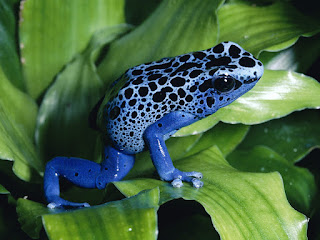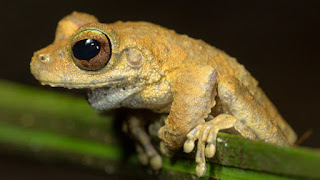Miscellaneous Archive
The Amazon Rainforest: The Wonders Of Earth's Most Unexplored Wilderness, Explained
The Amazon rainforest is the largest remaining tropical rainforest in the world. It's also the most biodiverse. One in ten of all known species are found here, including many that are endangered and found nowhere else. It's big and it's beautiful, and it's vitally important, not least because it stores vast amounts of carbon, influences rainfall patterns across South America, and affects climate on a much broader scale.
In the last 40 years, around a fifth of the rainforest has been felled or burned to make way for cattle ranches and other activities. Now scientists fear it's on the verge of irreparable damage. We lose it at our peril.
We need to act now to save one of the world's last true wonders.
The Amazon Rainforest covers 5.5 million square kilometres of South America. Base image by Getty Images
Spanning nine nations including Brazil, Peru and Colombia, the Amazon rainforest occupies 5.5 million square kilometres. Less than half of this area is protected. The Amazon River, which runs through it, flows for more than 6,500km. It's the world's second longest river after the Nile and is responsible for around 15 per cent of the planet's total river discharge into the oceans.
Who lives in the Amazon rainforest?People have been living in the Amazon for at least 10,000 years. Ancient settlers cultivated native trees such as the Brazil nut, maripa palm, and cocoa tree, and in time this influenced the rainforest's makeup. The southwestern section, for example, is rich in these species.
When the first Europeans arrived in South America in the late 15th Century, there were about 6.8 million indigenous people living there. The colonists carried infectious diseases, such as malaria and influenza, that killed millions of Amazonians. Thousands more were enslaved or displaced.
Indigenous leader Cacique Raoni Metuktire of the Kayapo tribe, watches as various tribes perform ceremonial dances for him, in Piaracu village, near Sao Jose do Xingu, Mato Grosso state, Brazil. Photo by CARL DE SOUZA/AFP via Getty Images
Today, around 30 million people live in the Amazon region, of which 2.7 million are indigenous, representing more than 350 different ethnic groups. Most live in indigenous reserves known as 'resguardos' where their lifestyles incorporate a mix of traditional and Western elements. Around 60 tribes, however, live in voluntary isolation, and stick largely to the tried and tested ways of their ancestors.
How much biodiversity is there in the Amazon?The Amazon is home to at least 10 per cent of the world's known biodiversity. From hummingbirds to hoatzins, there are more than 1,000 different species of birds. There are over 500 different reptile species, including black caiman and green anacondas, and more than 400 species of amphibians, including the giant cane toad and the notoriously toxic poison dart frog.
More like this
The Golden Poison Frog (aka Golden Dart Frog), Phyllobates terribilis, is the most poisonous frog in the world. It's become endangered due to habitat destruction within its naturally limited range. Photo by Getty Images
The region is a refuge for more than 300 species of mammals, including giant otters, ocelots and sloths. It is also one of the last refuges for jaguars and pink river dolphins. The Amazon River contains around 3,000 freshwater fish species, which is more than any other river system. One in five fish species live here.
There are an estimated 2.5 million insect species. And on just one tree, there can be more types of ant, than there are in some countries. Let's not forget the plant life either. The rainforest contains around 80,000 plant species, including 390 billion trees of around 16,000 species.
This tree frog has translucent skin on its belly, which makes its internal organs clearly visible from underneath. Elsewhere its skin is pale green, camouflaging it amidst the forest's foliage. Photo by Getty images
How old is the Amazon?No one knows for sure. Some think that the Amazon rainforest began to form during the Eocene, around 55 million years ago, after temperatures dipped and the Atlantic Ocean widened enough to provide the region with a warm, moist climate.
Some experts think it happened later, around 15 million years ago, after the South American and Nazca tectonic plates smashed together to form the Andes, creating a massive freshwater lake that covered the Amazon basin. Several ice ages later, and water started to flow from the Andes into the ocean. The Amazon River was born. Sediments from the mountains washed into the Amazon basin, creating the soils needed for the rainforest to grow.
The age of the Amazon rainforest is contested among experts. Photo by Getty Images
Others think it is more recent still. One study suggests that up to a fifth of the Amazon basin could have been grassland until a natural shift to a wetter climate around 2,000 years ago prompted the growth of more trees.
Why is the Amazon so important?Every species that lives here is important, not just in its own right, but because it plays an important role in the broader ecosystem. There are predators, scavengers, seed dispersers, decomposers and pollinators, to name but a few.
They provide vital resources for the indigenous people who still live here, as well as a reservoir of potential solutions to global-scale problems. The discovery of ACE inhibitors, which are now routinely used to treat high blood pressure, was inspired by studies of the venomous Brazilian viper.
Meanwhile, leaf-cutter ants, which collect leaves to fertilise the fungi on which they feed their larvae, avoid foliage rich in natural fungicides. Studying them could help us to discover new antifungal compounds.
The Amazon rainforest is sometimes called the 'lungs of the Earth' because it 'breathes in' carbon dioxide and 'exhales' oxygen on a massive scale
The Amazon Rainforest is often called the "lungs of the Earth". Photo by Getty Images
Water vapour released from the forest creates enormous 'flying rivers' in the sky, influencing weather systems near and far. Up to 50 per cent of rainfall in the Amazon comes from the forest itself, but it also delivers rain as far south as Argentina, where it helps to support agriculture.
The bigger picture, however, centres on the rainforest's ability to store carbon. The Amazon rainforest is sometimes called the 'lungs of the Earth' because it 'breathes in' carbon dioxide and 'exhales' oxygen on a massive scale. About 123 billion tons of carbon is sequestered in the Amazon's forests and soils.
What happens if we keep cutting the Amazon down?The rainforest is being felled to make way for cattle ranches, and plantations of soy and other crops. Climate change, mining, timber production and the development of roads, houses and other infrastructure are also contributing to its demise.
More than 18 per cent of the Amazon rainforest has so far been destroyed, and a further 17 per cent is degraded. As their habitats disappear, many species, such as the golden lion tamarin and the South American tapir, are being driven to extinction.
The Amazon basin has, until recently, absorbed large amounts of carbon emissions, but studies indicate the rainforest is hurtling toward a "tipping point," at which it will dry up and turn to savannah. Photo by CARL DE SOUZA/AFP via Getty Images
Felling and burning eliminates carbon dioxide-absorbing trees, and releases their stored carbon back into the atmosphere.
A study from 2021 revealed that every year, the rainforest is now emitting around one billion tonnes of carbon dioxide more than it can absorb. A vital carbon sink is turning into a carbon emitter.
The destruction of the Amazon rainforest is fuelling climate change, and now scientists fear it is close to a tipping point, beyond which it will be unable to generate its own rainfall and support its ecosystems. Parts of the rainforest could morph into fire-prone, arid savannah. With few trees, the carbon-sequestering ability of this land would be further eroded, with negative repercussions for climate change.
How much of the Amazon is still unexplored?Trekking through the dense, intact rainforest is not easy, so parts of the Amazon rainforest remain unexplored. No one knows exactly how much is unchartered, but technology is helping researchers to study these hard-to-reach areas.
Scientists flew a remote sensing device over part of the Bolivian Amazon, using a laser to map the land. The images, released last year, revealed the presence of two ancient settlements, complete with conical pyramids, earthen buildings and artificial terraces, surrounded by a network of raised causeways (pictured below). People probably lived in the areas around the terraces, and used the causeways to get around. There were also reservoirs and canals.
Two ancient settlements have been discovered deep in the Amazon Rainforest.
The site confounds the prevailing narrative which dictates that before the Europeans arrived, the Amazon was a pristine wilderness, unchanged by the indigenous populations.
Instead, it's now thought the land was modified by the Casarabe culture, who lived here between 500 and 1400 AD. It's yet another reason to study and preserve the Amazon. Scientists now think there could many other lost cities just waiting to be found.
Can the Amazon rainforest be regrown?It's better not to cut it down in the first place, but given time, tropical rainforests can sometimes regenerate. According to one study of rainforests across three continents, soil takes around 10 years to regain its original status, plant and animal biodiversity takes around 60 years, and overall biomass takes around 120 years.
This is largely due to a phenomenon called 'secondary succession', where nearby pockets of forest and flora help to fuel new growth. Left alone, some tropical forests can achieve around three-quarters of their old-growth status in just 20 years.
It's a better approach than planting new trees. The same study found that natural regeneration outperforms restoration planting in terms of biodiversity, recovering nutrients and mitigating climate change. This is only possible, however, if there is enough flora and fauna nearby to seed the change.
Brazil is home to around 60 per cent of the rainforest. It's promising, then, that at the COP27 climate summit in Egypt's Sharm El Sheikh, Brazil's recently-elected president, Luiz Inácio Lula da Silva promised to stop all deforestation and degradation in the Amazon by 2030.
Read more:
New Frog Species With "groins Of Fire" Discovered In Amazon With Colors That Resemble Flames
One million species are at risk of extinction because of human activity
SHARE
SHARE
TWEET
SHARE
What to watch next

Sandy Hook survivor: I beat the odds somehow. I should have died and I didn't
CNN
Sudan army suspends truce talks: diplomatic source
Reuters
Dashcam captures moment of missile part falling close to car on move in Kyiv
Reuters
Dash cam video shows missile debris almost hitting Kyiv bus
CNN
See preview of Paul Newman, Joanne Woodward items for auction
TODAY
Chris Christie set to enter the 2024 presidential race
MSNBC
Eric Cantor on debt ceiling deal: It's all about how your constituents view your vote
CNBC
White House confident Congress will pass debt limit agreement
Scripps News
Video Of Joe Biden's Memorial Day Salute Fail Goes Viral
Newsweek
Former first lady Rosalynn Carter diagnosed with dementia
CBS News
Japan prepares to release treated radioactive water from Fukushima nuclear disaster into sea
CBS News
Outrage grows in Davenport, Iowa, as officials say 2 people may be in collapsed building wreckage
CBS News
Russia accuses Ukraine of drone strike on oil refinery inside Russian territory
CBS News
Debt ceiling bill 'reflects realities of divided government' as it passes key committee
USA TODAY
Car flies 120 feet after driving up tow truck ramp at full speed
TODAY
Rep. Clyburn: We are at the limit in large measure because of what happened under Trump
MSNBCClick to expand
UP NEXT
Germán Chávez is no stranger to the Amazon rain forest, where he says "one can't help but get excited" by all the reptiles and amphibians that he has made a career out of studying. But when he came across one frog, all he could think was "Bloody hell!"
It all happened when he went to the Amazon lowlands in central Peru with fellow researcher Wilmar Aznaran. The area is frequented often, he said, which made them both "quite surprised and kind of speechless" when they came across a new frog species, which he said in a blog post is "clearly different from any other similar species."
"That was evident for us at the very moment we caught it," he said. "...We could not believe that a medium-sized arboreal frog had passed in front of other researchers' eyes, and remained unseen."
They soon realized the frog before them "is not a common species in the area." They were only able to find two of the frogs, even after going back to the site a few months after the original encounter.
"At that point, we knew that we had a new species on (our) hands, but describing it with only two specimens was challenging," Chávez said in his blog post.
Eventually, they got some other team members on board so they could further conduct their study, published in Evolutionary Systematics earlier this month. They found the frogs have orange patterns on their groins, thighs and shanks that "resembles flames," Chávez said – just "like those threatening its habitat." This led to the determination of its name, Scinax pyroinguinis, which translates to "groins of fire."
 © Provided by CBS News On left, a wildfire is seen in the vicinity of the type locality during researches' fieldwork in studying the new frog species. On the right is a stream and surrounding vegetation in Quebrada Blanca, where specimens of the new species were caught in central Peru. / Credit: Rising from the ashes: A new treefrog (Anura, Hylidae, Scinax) from a wildfire-threatened area in the Amazon lowlands of central Peru
© Provided by CBS News On left, a wildfire is seen in the vicinity of the type locality during researches' fieldwork in studying the new frog species. On the right is a stream and surrounding vegetation in Quebrada Blanca, where specimens of the new species were caught in central Peru. / Credit: Rising from the ashes: A new treefrog (Anura, Hylidae, Scinax) from a wildfire-threatened area in the Amazon lowlands of central Peru Wildfires are a "serious threat" to their habitat, as the flames continue to threaten the Amazon rainforest at large.
In September, the rainforest had its worst months for fires in more than 10 years, according to the Associated Press, citing national Brazil data. During that month, the media outlet reported that there were more than 42,000 fires within 30 days. Those fires destroyed 434 square miles of rainforest the outlet reported, an area more than 100 square miles bigger than New York City.
Milwaukee Public Museum Shares Plans For Rooftop Terrace, Updated Exhibits In New Building
MILWAUKEE (CBS 58) -- The Milwaukee Public Museum held its fifth and final gallery reveal, which includes two fan favorites and a new rooftop terrace.
The Bucyrus Rooftop Terrace, unveiled Tuesday, is set to be a year-round space for visitors.
"It's not only to be a relaxing place to enjoy the fresh air, but it will also function as an outdoor classroom and special events space," Milwaukee Public Museum President & CEO Dr. Ellen Censky said.
Two current exhibits will be moving to the new building, the We Energies Foundation Gallery: Rainforest and the Puelicher Butterfly Vivarium.
One of the first permanent exhibitions of its kind, the rainforest gallery transports you to the tropics. In the new museum, the birds that migrate south will lead you to the exhibit.
"So, if you could imagine taking that journey with these beautiful birds and insects mounted up high, and then you find yourself in this immersive, lush, gallery landscape," Senior Curator of Thinc Design Helen Divjak said.
You will also hear the many sounds of the rainforest and see its native species, like poison dart frogs and tarantulas.
After you leave the rainforest and its critters, you will be greeted by the free-flying butterflies and moths that so many love. In a YouTube video explaining the updated exhibits, Censky reveals the public wanted to see it in the new building.
"In polling the community for what their favorite exhibits are, the butterflies always were way up at the top," she said.
The museum will be housed in the Haymarket neighborhood. It will cover 200,000 square feet, blocks away from Deer District, standing at five stories. It is slated to open in 2026.





Comments
Post a Comment